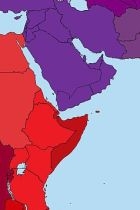Piracy Update: Gulf of Aden

The overall maritime threat is assessed as LOW; i.e. incidents are possible but not likely.
Over the past year, the number of confirmed and suspicious at-sea incidents (e.g. boardings, robberies, hijackings, etc.) has declined significantly, to the point where most incidents in the Gulf of Aden are characterized by the UK Maritime Trade Operations (UKMTO) center in Dubai as suspicious approaches.
In reality, most of these incidents reflect normal patterns of life. Sighting of “dhows towing multiple skiffs or clusters of small boats operating closely together” are common and consistent with fishing activities in the area.
There are two specific situations which should be noted by yachtsmen transiting the Gulf:
(1) The security situation throughout Yemen continues to be unsettled, despite a ceasefire scheduled to go into effect at midnight on 10 April. Three or four separate groups have been battling for control of the country since March of last year. Although peace talks are planned for 18 April in Kuwait - between the Saudi-led coalition supporting the internationally recognized government of Abd Rabbuh Mansur Hadi, and rebels (the Houthis) who are nominally allied with former Yemeni President Ali Abdullah Saleh and are supported by Iran – the prospect for a near-term reduction in tensions is minimal.
Complicating the situation is the presence of Islamic extremists, with much of the country remaining under the de facto control of the regional al-Qaeda faction (al-Qaeda in the Arabian Peninsula – AQAP), including the cities of Mukalla and Ash Shihr on the Gulf of Aden – or groups allied with the Islamic State of Iraq and the Levant (ISIL; also referred to as IS or ISIS).
Regardless of the results of the Kuwait peace talks, and despite the publically stated intention of Saudi Arabia to withdraw their military forces from the country, anticipate that the naval quarantine zone established by the Saudi Navy along the Yemeni coast in the Gulf of Aden and the Red Sea will remain in place for the foreseeable future.
As far as the Saudis are concerned, the quarantine serves as a deterrent, keeping Iran from resupplying their Houthi clients (and, by inference, from extending their power into the Saudi sphere of influence on the Arabian Peninsula). However, the naval quarantine also has the effect of discouraging any would-be pirates from operating in the Gulf of Aden – thus contributing to the reduced threat level.
With respect to the port of Aden, while the facility itself is under the control of the Hadi government coalition, the situation remains unstable. Maritime operations in/around the port area should occur only after consultation with Saudi Navy and Yemeni government authorities.

(2) The other factor affecting yachts operating in the Gulf of Aden is the volume of irregular migration between Yemen and countries in the Horn of Africa. According to the United Nations High Commissioner for Refugees (UNHCR), over 90,000 migrants arrived in Yemen in 2015 by crossing the Gulf of Aden or the Red Sea. Conversely, during the same time period, 72,000-plus migrants made the crossing from Yemen to Djibouti, Ethiopia, Somalia, and Sudan.
Although migrants attempting to enter Europe by crossing the Mediterranean are far more numerous (and has received much more publicity), the number of migrants attempting a crossing of the Gulf of Aden is not insignificant. Given the relatively small geographic area of the Gulf, there is a reasonably high chance that yachts in the area may have an encounter – and should be prepared to respond.
Two other factors regarding the Gulf of Aden are worth noting:
-
As feasible, a very effective measure with regards preventing suspicious activity is to use the Internationally Recommended Transit Corridor (IRTC) when making an east-to-west (or vice versa) of the Gulf of Aden. The IRTC serves as a de facto focal point for maritime security capabilities in the Gulf, so taking advantage of the Corridor, consistent with navigational requirements and good seamanship, is encouraged.
-
The Gulf of Aden, along with all of the waters near and adjacent to the Arabian Sea, is subject to monsoon conditions twice a year, with the Northeast Monsoon running roughly from December to March; and the more intense Southwest Monsoon from June to September. During the transition seasons (late March-May and late September-November), weather conditions are favorable for small boats associated with pirate operations. Please remember, during these or any other times, vessels exhibiting suspicious activity or operating in an aggressive or threatening manner should be reported to the UKMTO.
In summary, while at the moment piracy in the Gulf of Aden is at low ebb, many of the economic and political conditions which caused it to surge starting about 2008 still exist. Given the reduction of in- area naval forces dedicated to maritime security, remain alert to the possibility of an approach given that a transit of the Gulf of Aden is well within the confirmed range of pirates operating small craft from the coast of Yemen, Somalia and Oman.
For further information, to discuss the report or to find out more about Securewest’s services please contact:
Wayne Britton
Email: waynebritton@securewest.com
Website: www.securewest.com
* Image credits: Google Maps;wikimedia commons CC BY 3.0


Post your comment
You cannot post comments until you have logged in.
Login to post a commentComments
No one has commented on this page yet.
RSS feed for comments on this page | RSS feed for all comments